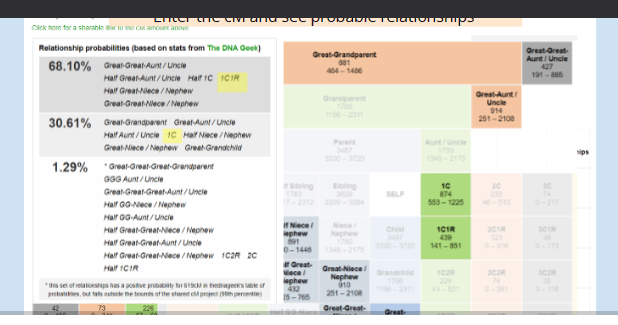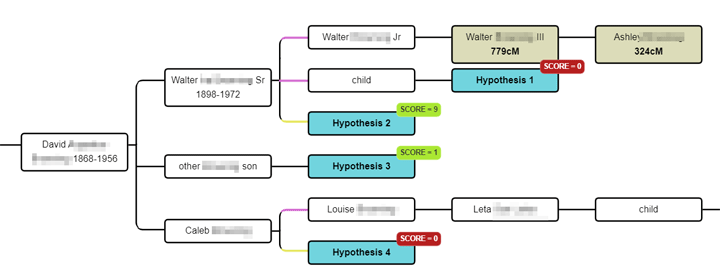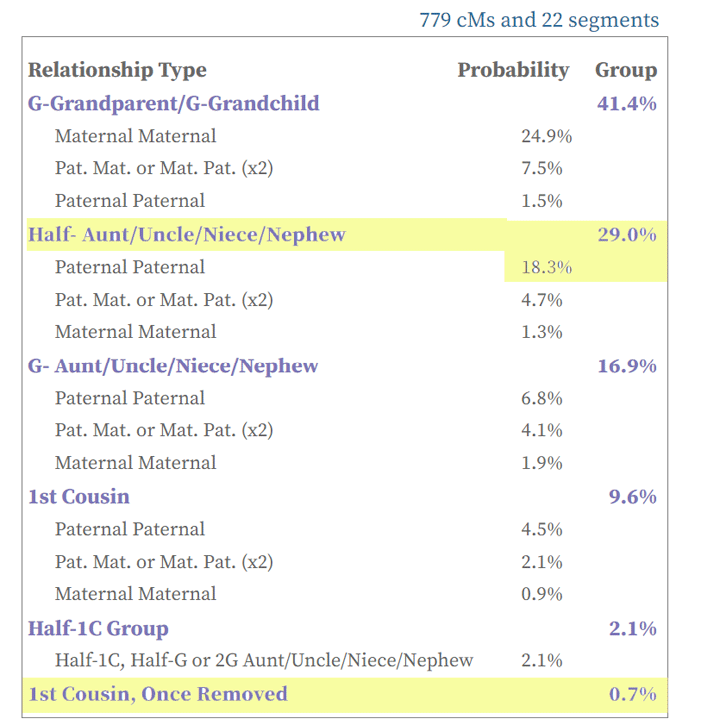Segment sizes matter for predicting the closeness of a relationship. That is because inherited DNA chunks get divided up with each generation’s recombination, becoming smaller over time. It has often puzzled me that none of the DNA relationship calculators take that into account. The total centimorgans (cM) can be similar for lots of different relationships. Click here for my post on telling half siblings apart from aunt/uncle/niece/nephew relationships by using segment sizes.
Click here for Ancestry’s explanation of how they predict relationships and here for the article at 23andme. Neither mentions segment sizes.
My favorite calculator has long been the one at DNA Painter where the table is based on Blaine Bettinger’s collected data and the probabilities are by Leah Larkin based on the Ancestry white paper. It can work from a percentage or a cM value and lights up just the possible relationships in its table. Clicking on any table entry gets a histogram of frequencies. I have slides showing how nicely it works, done for a recent talk about 3rd party DNA tools for the SCGS jamboree. Click the image above to see those. That video should be available to attendees from the web site genealogyjamboree.com
Recently a calculator was published at DNA-SCI which includes segment sizes by asking for the number of segments. I have used it for a number of closer relationships and have been very impressed with its results.
“B,” tested his DNA looking for his unknown father. I built a WATO model from his many matches (shown above). It indicated that one father was nine times more likely than any of his brothers. The evidence was that shortly before his wedding, either Walter Sr. or one of his out of town brothers had relations with a divorcee which produced a child. That child, “B,” now wanted to know which brother it was, but none of their descendants replied to his queries. He shares 779 cM over 22 segments with the grandson of Walter Senor and his Y test clearly indicates their surname.
So the question was could segment sizes narrow it down more? The range of shared DNA for a half nephew (492-1315) and a first cousin once removed (102-980) overlap. However since the half nephew is fewer recombinations away, likely there will be bigger segments for that relationship. Below is the calculation from the SegcM tool at DNA-sci. Highlights are mine.
Jonny Perl (DNApainter) said recently that when a new very useful feature is invented by a 3rd party, the main testing companies soon follow. Click here for that talk about 3rd party tools at Rootstech. I hope this happens for the use of segment sizes in DNA relationship calculations!



The notable exception is auto clustering, which Ancestry has not picked up.
When 3rd party AutoClustering had access there, some apps were greedy users that gobbled up available resources. Ancestry has chosen to go with other features like ThruLines(TM), which is probably better for most people, particularly newbies who Ancestry seems to focus its tools on. But it can be fooled by false trees. AutoClustering is not misled in that way. They are complementary tools for me at another place where both exist.
My outside the box cMs is: My 4th C, Eric, and I share 5 segments with a total of 102 cMs, and longest cM, 51.
My GREAT granddaughter and Eric share 1 segment with 34 total cMs, and longest cMs, 34.
That segment stayed stong passing down to my GREAT granddaughter.
It is not unusual for a large segment to persist over many generations. Could you be related to Eric in more than one way? According to the calculator at https://dnapainter.com/tools/sharedcmv4 this is possible if somewhat unlikely
There’s a match on Ancestry that shares a 52 cM segment with me. It’s the one and only segment that we share. But there’s NO common ancestors on our trees–NONE. Both trees are very detailed, so it’s not a matter of one of us needing to build our tree out further.
I’m thinking there may be a Nonpaternal Event (NPE), but don’t want to jump to conclusions.
Any thoughts on this?
Sometimes a large segment can persist for hundreds of years. How far back do your 2 trees go?
So no, I would not think an NPE unless there is a large group of unexplained matches.
Perhaps you could upload to GEDmatch and buy tier 1 for a month so you can run a segment search on that segment and see who else matches it.